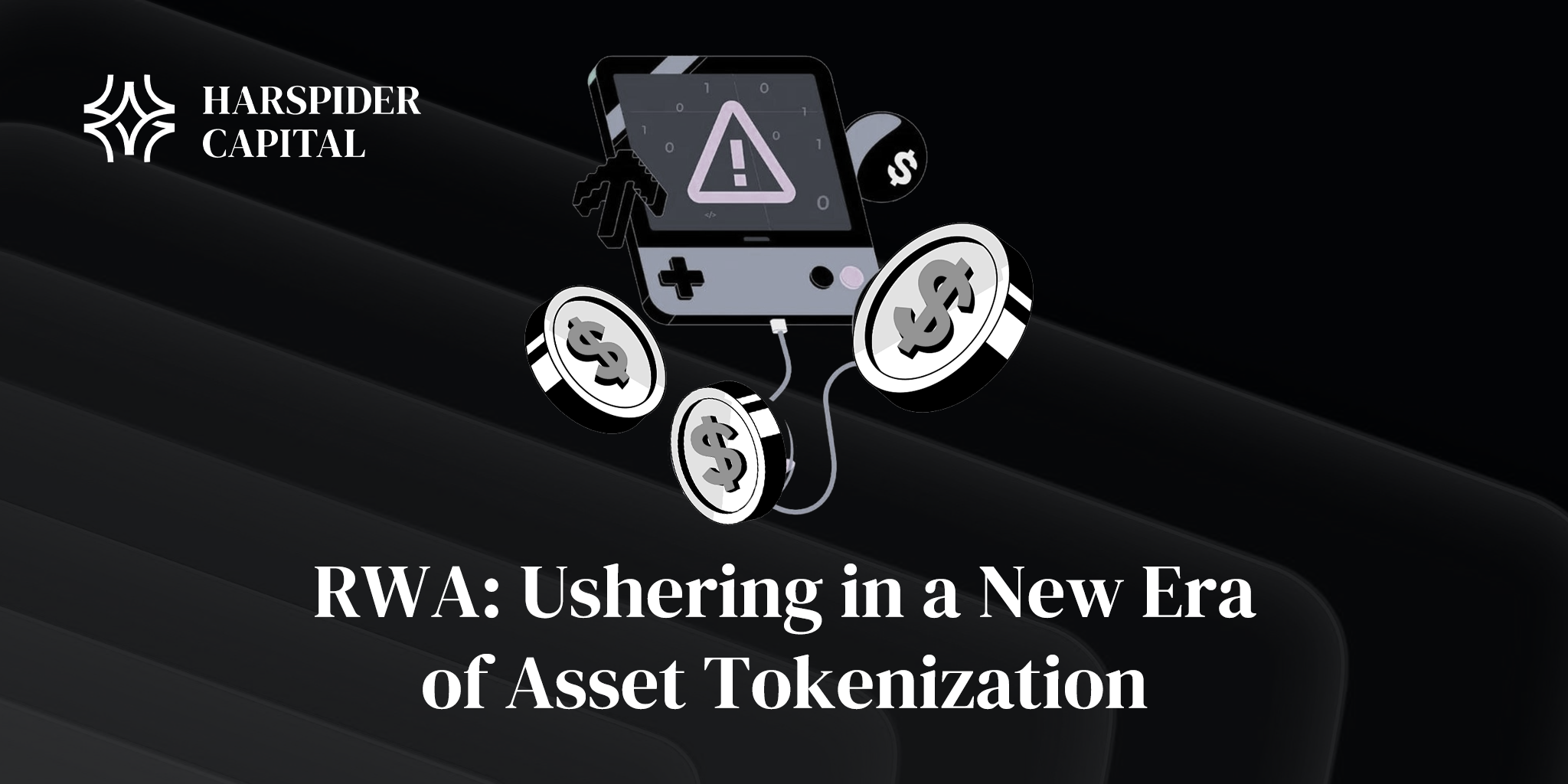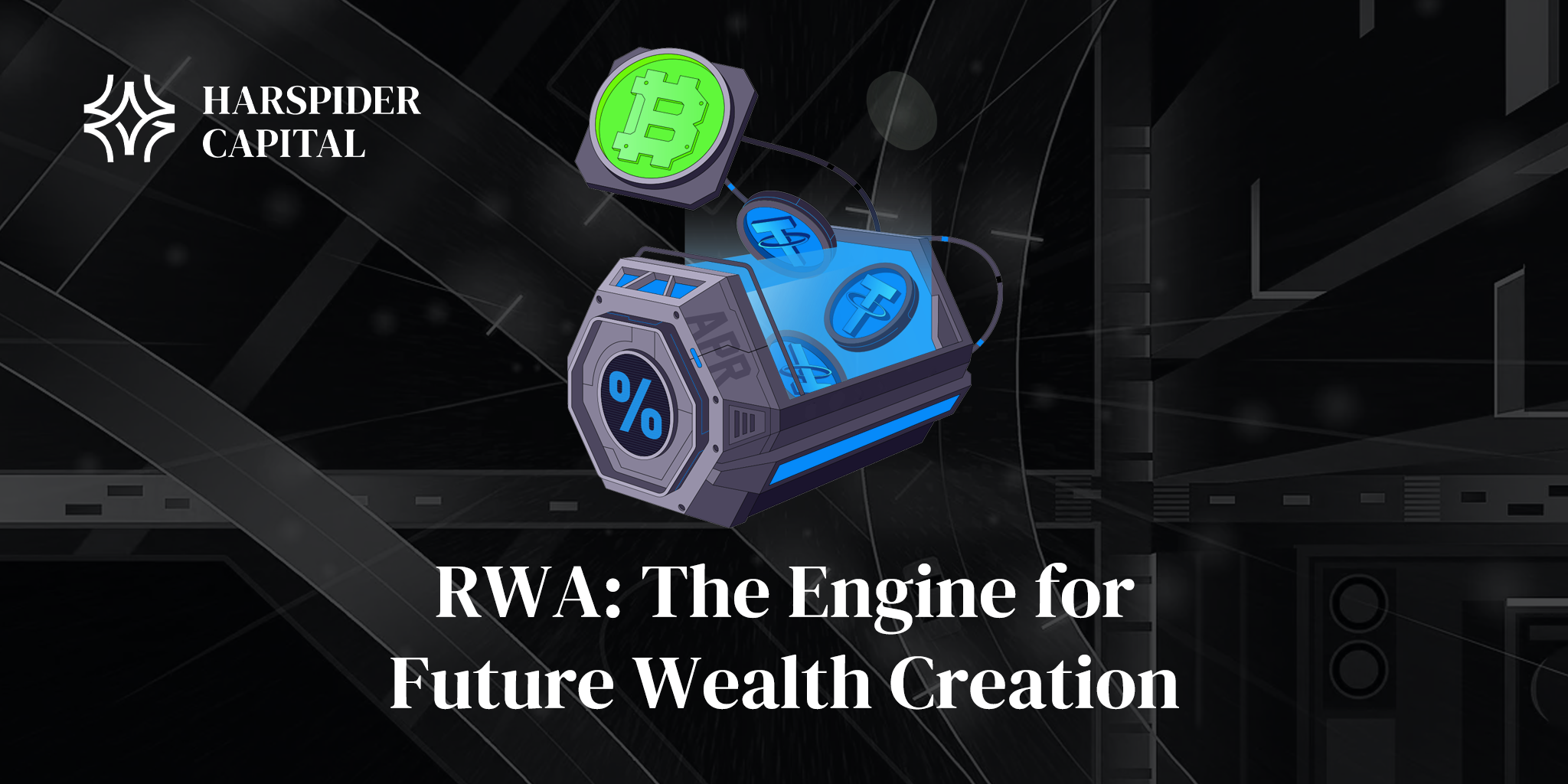
1. Introduction
Real World Assets (RWA) represent a pivotal bridge between blockchain technology and traditional finance, emerging as one of the most promising tracks in the crypto market. By tokenizing real-world tangible assets (such as real estate, bonds, and art) and integrating them onto the blockchain, RWA significantly enhances asset liquidity, transparency, and global accessibility. According to industry data, the total value locked (TVL) in the RWA market has surged from $757 million in early 2023 to $42.1 billion by May 2025, a 55-fold increase, underscoring the track’s immense potential.
This report provides an in-depth analysis of the RWA track’s market landscape, leading projects, risks, opportunities, and Harspider Capital’s investment recommendations to help investors capitalize on this transformative trend.
2. RWA Track Background and Market Overview
2.1 Definition and Core Value of RWA
Real World Assets (RWA) refer to the tokenization of tangible or intangible real-world assets (such as real estate, commodities, bonds, or intellectual property) on the blockchain, transforming them into digital assets tradable on-chain. The tokenization process leverages smart contracts to digitize asset ownership, significantly reducing transaction costs, improving market efficiency, and enabling fractional ownership to make high-value assets more accessible to retail investors.
The core value of RWA includes:
-
Enhanced Liquidity: Traditional assets like real estate often face long transaction cycles and high costs. Tokenization enables 24/7 global trading, significantly improving liquidity.
-
Transparency and Security: Blockchain’s immutability ensures transparent transaction records, reducing fraud risks.
-
Global Accessibility: Tokenized assets break geographical barriers, allowing global investors to participate.
-
Diversified Investment Opportunities: RWA combines traditional financial assets with the crypto market, reducing single-asset-class risks.
According to Boston Consulting Group, the global tokenized financial asset market is projected to reach $16 trillion by 2030, accounting for over 10% of global financial assets. Harspider Capital believes the RWA track is not only a breakthrough for blockchain applications but also a critical area for the convergence of traditional finance and decentralized finance (DeFi).
2.2 Market Status and Growth Drivers
From 2024 to 2025, the RWA track has been propelled by both traditional financial institutions and crypto-native projects. Major financial giants like BlackRock, JPMorgan, and Goldman Sachs have accelerated RWA adoption by launching tokenized funds (e.g., BlackRock’s BUIDL fund). Meanwhile, DeFi protocols have integrated RWA assets (such as U.S. Treasuries and real estate) to offer new yield opportunities, further driving market growth.
According to DeFiLlama, as of May 2025, the RWA track’s TVL has reached $42.1 billion, a significant increase from $6 billion in April 2024. Key growth drivers include:
-
Institutional Participation: The entry of traditional financial institutions has boosted market confidence. For instance, BlackRock’s BUIDL fund, launched in March 2024, quickly attracted substantial institutional capital.
-
Regulatory Progress: Regions like Switzerland, Singapore, and Hong Kong have fostered RWA tokenization through sandbox regulations and clear legal frameworks.
-
Technological Innovation: Cross-chain interoperability protocols (e.g., Chainlink CCIP) and decentralized identity solutions (e.g., ONCHAINID) have improved RWA’s on-chain efficiency and compliance.
Through in-depth market trend analysis, Harspider Capital believes the RWA track’s growth will continue to accelerate over the next 5-10 years, particularly in real estate, fixed-income assets, and emerging market credit.
3. Analysis of Leading RWA Projects
Harspider Capital has selected five representative RWA projects for evaluation based on their technological innovation, market influence, ecosystem completeness, and growth potential: Chainlink, Ondo Finance, MakerDAO, Centrifuge, and Propy.
3.1 Chainlink (LINK)
Project Overview: Chainlink is a core infrastructure provider for the RWA track, delivering reliable off-chain data to blockchains through its decentralized oracle network, enabling RWA tokenization and on-chain management. Its Cross-Chain Interoperability Protocol (CCIP) supports seamless transfers of tokenized assets across multiple blockchain ecosystems.
Key Strengths:
-
Provides real-time data feeds, ensuring accurate on-chain valuation of tokenized assets (e.g., real estate, bonds).
-
CCIP enhances cross-chain settlement, improving RWA interoperability.
Strong partnerships with RWA projects like Backed and Paxos, demonstrating high market recognition.Market Performance: As of May 2025, LINK’s token price is $14.54, with a high market cap ranking and a 24-hour trading volume of $260 million, reflecting robust market activity.Harspider Capital Assessment: Chainlink’s role as the “data pipeline” for the RWA ecosystem makes it indispensable. Its long-term importance will grow further, making it suitable for conservative investors.
3.2 Ondo Finance (ONDO)
Project Overview: Ondo Finance focuses on tokenizing fixed-income assets, such as its USDY stablecoin backed by U.S. Treasuries. Its decentralized AI platform (Ondo DeFAI) optimizes investment strategies, attracting both institutional and retail investors.
Key Strengths:
-
Offers stable-yield tokenized products, ideal for investors seeking low-risk returns.
-
Significant TVL growth in 2024 reflects strong market demand for its products.
-
Partnerships with traditional financial institutions enhance compliance and credibility.
Market Performance: ONDO’s token has shown strong performance in 2024, driven by demand for fixed-income RWA products.
Harspider Capital Assessment: Ondo Finance’s focus on fixed-income RWAs positions it as a preferred choice for institutional investors, though market volatility may impact its yield strategies.
3.3 MakerDAO (MKR)
Project Overview: MakerDAO, a DeFi pioneer, integrates RWAs (e.g., U.S. Treasuries) through its DAI stablecoin. In 2024, its Sky Protocol (USDS and SKY tokens) further advanced RWA on-chain applications.
Key Strengths:
-
80% of protocol revenue comes from RWAs, highlighting its leadership in the track.
-
The Endgame plan enhances decentralized governance through sub-DAOs managing RWA assets.
-
A $100 million tokenized U.S. Treasury investment underscores its strategic focus on RWAs.
Market Performance: MKR’s token has maintained steady growth in 2024, with rising TVL.
Harspider Capital Assessment: MakerDAO’s mature ecosystem and RWA strategy make it a strong long-term investment, though regulatory risks to its stablecoin require monitoring.
3.4 Centrifuge (CFG)
Project Overview: Centrifuge focuses on on-chain credit markets, enabling businesses to tokenize receivables, invoices, and other assets, connecting DeFi investors with emerging market borrowers. Its Anemoy platform streamlines asset tokenization.
Key Strengths:
-
Cross-chain, asset-agnostic tokenization platform with high flexibility.
-
Strong ecosystem integration with MakerDAO, Aave, and others.
-
Focus on emerging market credit fills gaps in traditional financial services.
Market Performance: CFG’s token has seen significant market cap growth in 2024, with a TVL of $700 million.
Harspider Capital Assessment: Centrifuge’s focus on emerging market credit offers high growth potential, but investors should monitor on-chain credit default risks.
3.5 Propy (PRO)
Project Overview: Propy specializes in real estate tokenization, enabling fractional ownership and trading of properties on the blockchain. Its platform collaborates with real estate professionals and regulators to ensure compliance.
Key Strengths:
-
A pioneer in real estate tokenization with a clear market niche.
-
Partnerships with regulators reduce legal risks.
-
User-friendly investment interface attracts retail investors.
Market Performance: Propy gained traction in 2024 due to the real estate RWA boom, with steady token price growth.
Harspider Capital Assessment: Propy’s first-mover advantage in real estate RWA makes it appealing, but its token value may be influenced by real estate market cycles.
4. Risks and Challenges in the RWA Track
Despite the RWA track’s immense potential, Harspider Capital advises investors to consider the following risks:
-
Regulatory Uncertainty: Differing regulations across jurisdictions may limit the global expansion of RWA projects. For example, U.S. regulations on tokenized securities remain unclear.
-
Default Risk: On-chain credit protocols (e.g., Centrifuge) may face borrower default risks, particularly in emerging markets. The 2022 crypto market crash led to significant losses for some protocols.
-
Valuation Transparency: Tokenized asset valuations may lack transparency, and operational costs could inflate token prices, affecting investor returns.
-
Technical Risks: Smart contract vulnerabilities and blockchain security issues could lead to asset losses, necessitating investment in technically robust platforms.
5. Opportunities and Trends in the RWA Track
Harspider Capital identifies the following trends shaping the RWA track:
-
Accelerated Institutional Adoption: Traditional financial institutions will continue to increase RWA investments, with the market projected to exceed $50 billion by the end of 2025.
-
Emerging Market Growth: RWA applications in emerging markets (e.g., microloans, trade finance) will drive financial inclusion, attracting more capital.
-
Cross-Chain Interoperability: Technologies like Chainlink CCIP will enhance RWA integration across multiple chains, improving transaction efficiency.
-
Diversified Asset Classes: Beyond real estate and fixed income, tokenization of non-traditional assets like art and intellectual property will expand the market.

6. Harspider Capital’s Investment Strategy Recommendations
Based on comprehensive research, Harspider Capital offers the following investment recommendations:
-
Core Allocation: Allocate 20%-30% of the portfolio to RWA infrastructure projects (e.g., Chainlink) to capture the track’s overall growth.
-
High-Growth Opportunities: Invest in protocols focused on fixed-income and emerging market credit (e.g., Ondo Finance, Centrifuge) for high-yield potential.
-
Real Estate Tokenization: Consider Propy for stable, long-term returns in real estate RWA.
-
Risk Management: Diversify investments across asset classes and regions to mitigate single-project risks, while closely monitoring regulatory developments.
-
Dynamic Adjustments: Regularly track RWA projects’ TVL, market cap, and on-chain data, adjusting holdings based on Harspider Capital’s research reports.
7. Conclusion
The RWA track, as a convergence of blockchain and traditional finance, is reshaping the global financial landscape at an unprecedented pace. Through systematic analysis of market trends, leading projects, risks, and opportunities, Harspider Capital believes RWA will become a dominant narrative in the crypto market over the next 5-10 years. Investors should seize opportunities driven by institutional adoption and technological innovation while remaining vigilant about regulatory and market volatility risks.




评论 (0)